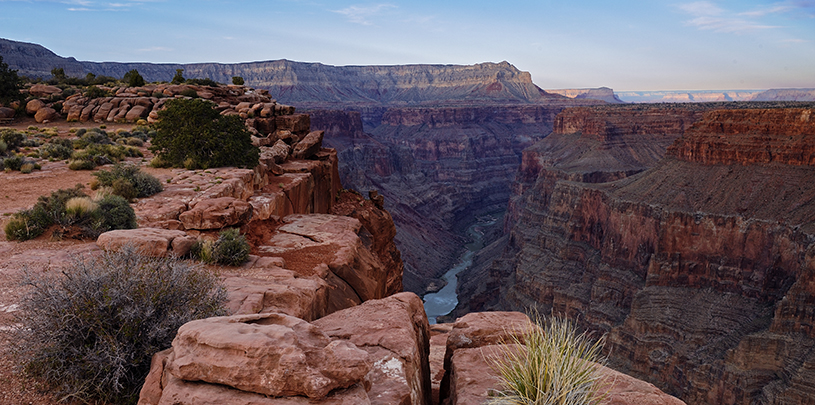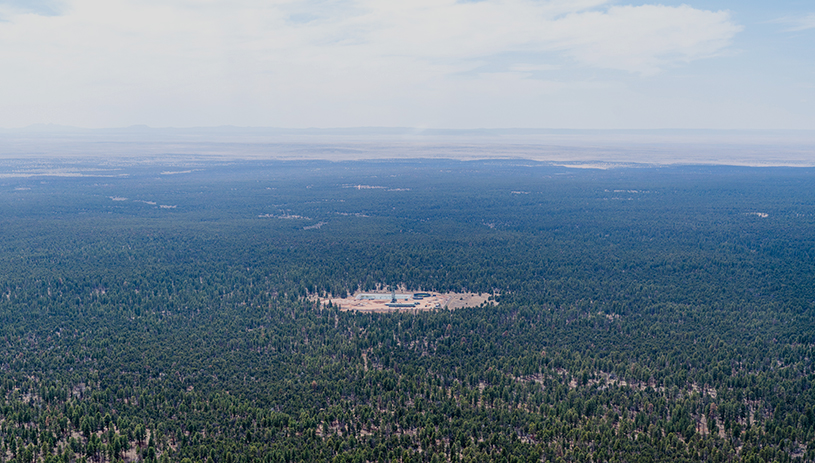
 by Amanda Podmore, Grand Canyon Director
by Amanda Podmore, Grand Canyon Director
On April 30, 2024, the Navajo Nation Council and Navajo Nation President Buu Nygren signed legislation calling on U.S. President Joe Biden and federal authorities to stop the transport of uranium ore across Navajo Nation lands immediately.
The move comes after the controversial Canyon Mine (renamed Pinyon Plain Mine) began mining uranium near Grand Canyon National Park and inside the boundaries of Baaj Nwaavjo I'tah Kukveni – Ancestral Footprints of the Grand Canyon National Monument in December 2023, as uranium prices spiked.
According to its owner, Energy Fuels Resources, Canyon Mine (Pinyon Plain Mine) expects to send about six trucks of uranium ore a day roughly 300 miles along local roads and state highways, through cities and towns in Arizona, the Navajo Nation, and Utah, to the company's White Mesa uranium mill for processing. The highways the haul trucks will travel are mostly two lanes (one lane each direction), winding, and unlit.
The Navajo Nation bans uranium mining and generally opposes and regulates the transport of uranium ore across Navajo lands, but the state of Arizona allows uranium to be transported over highways 89 and 160 across the Navajo Nation.
The uranium company has said it will inform the Navajo Nation when hauling begins, but discussions at recent meetings with federal, tribal, city, and county officials about the mine’s transportation and emergency response plans have cast doubt on the notification process and readiness of emergency responders along the haul route.
If the company moves ahead as planned, tourists headed for Grand Canyon National Park's main south rim entrance will soon pass large uranium haul trucks covered only in canvas tarps.
 Uranium haul truck near Kanab, Utah, June 2015. Trucks like this are expected to begin hauling uranium ore from Canyon Mine near the Grand Canyon later this year. BLAKE MCCORD
Uranium haul truck near Kanab, Utah, June 2015. Trucks like this are expected to begin hauling uranium ore from Canyon Mine near the Grand Canyon later this year. BLAKE MCCORDThe proposed haul route passes through the city of Flagstaff, Arizona, through Cameron, Tuba City, and Kayenta on the Navajo Nation, and through Bluff, Utah. Many communities along the haul route aren't happy about this and worry about the risks uranium mining and hauling pose to public health and safety, especially in light of possible accidents.
"[W]e’re not messing around when it comes to uranium being transported across the Navajo Nation," said President Nygren in a statement.
"With Highway 191 being the only road through town, we are deeply concerned about the lack of transparency about the transportation plan," said Bluff, Utah Mayor Ann Leppanen. "How can we ensure our first responders are adequately prepared and community members are safe in the event of an incident?"
The city of Flagstaff has long opposed the transport of uranium through the city and across Indigenous lands. And as recently as February 2024, the Coconino County Board of Supervisors — the second largest county in the United States by land area — passed a resolution opposing uranium transport through Flagstaff and tribal lands and urging the mine to close.
"Even setting aside potential concerns regarding geology, cultural significance, sacredness of the land, the potential environmental impacts, and possible water contamination, what part of a uranium mine next to the Grand Canyon, one of the natural wonders of the world, makes any sense?” asked Coconino County Supervisor Patrice Horstman.
The mine's owner hasn't taken kindly to this opposition, demanding that the county retract its resolution.
Many Native American tribes, including the Havasupai Tribe, the Hopi Tribe, the Hualapai Tribe, and the Navajo Nation strongly oppose uranium mining in the Grand Canyon region. The Havasupai Tribe has led opposition to Canyon Mine (Pinyon Plain Mine) since the 1980s, citing concerns about possible groundwater contamination, since the mine sits above the Havasupai Tribe's only source of water.
Native-led grassroots groups like Haul No also strongly oppose uranium transport across tribal lands.
Abandoned uranium mines litter the Navajo Nation, where they have contaminated land and water and harmed human health. Over 500 of these mines have yet to be cleaned up. And there have been accidents involving uranium haul trucks in the region.
In 1987, two separate accidents involving haul trucks resulted in uranium ore spilling across highways on the Navajo Nation and in 1997, a uranium haul truck jackknifed in Colorado Springs, spreading ore across Interstate 25 and closing the highway.
More recently in 2015 and 2016, trucks hauling waste from in-situ leaching uranium mines in Wyoming to the White Mesa Mill have leaked radioactive sludge along Utah's highways, including near the entrance to the White Mesa Mill, where residents of nearby White Mesa have been among the last to know. This underscores the need to notify potentially impacted communities as quickly as possible when there is an accident.
 Canyon Mine (also known as Pinyon Plain Mine) with the Grand Canyon in the background. ECOFLIGHT
Canyon Mine (also known as Pinyon Plain Mine) with the Grand Canyon in the background. ECOFLIGHT
The Navajo Nation emphasizes the need to "protect Navajo highways from the transportation of hazardous materials that can harm businesses, students, residents, and livestock" from the potential environmental and health hazards posed by uranium transport.
And the Havasupai Tribe wrote in a statement shortly after mining began at Canyon Mine (Pinyon Plain Mine): "A whole set of unknown and new problems will exist when the company begins transporting uranium over the land."
Canyon Mine (Pinyon Plain Mine) is expected to operate for 28 months and produce 1.57 million pounds of uranium — that’s once it’s milled from raw ore at the company’s White Mesa Mill — a drop in the bucket when it comes to U.S. uranium demand.
State regulators and the U.S. Forest Service, which manages the national forest land inside Baaj Nwaavjo I'tah Kukveni National Monument where the mine sits, claim there's nothing they can do to stop the mine.
Last month, conservation groups including the Grand Canyon Trust sent a letter to the Kaibab National Forest asking for information about how emergency responders, local governments, and residents will be notified when ore hauling from Canyon Mine (Pinyon Plain Mine) begins, how trucks will be marked, and who will be responsible for responding to any emergencies along the haul route. The Forest Service responded that it would notify "Tribes and other interested parties" when transportation begins.
The Navajo Nation's call on President Biden to stop the transport of uranium ore from Canyon Mine through the Navajo Nation still awaits a response.
Please let the U.S. Environmental Protection Agency Office of Environmental Justice and the U.S. Forest Service know that you oppose Canyon Mine (renamed Pinyon Plain Mine) near the Grand Canyon.
80% of Arizona voters support Baaj Nwaavjo I'tah Kukveni National Monument, according to a new poll.
Read MoreThe Colorado River below Glen Canyon Dam is heating up. Find out why.
Read MoreGroundwater pumping at a uranium mine near the Grand Canyon will affect the canyon's springs, scientists says.
Read More